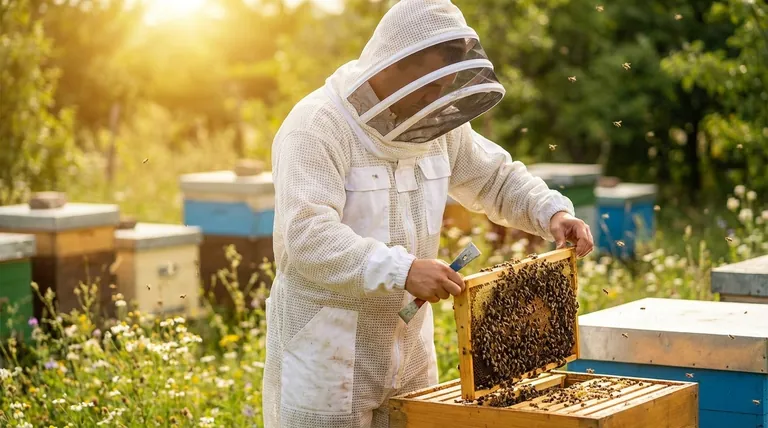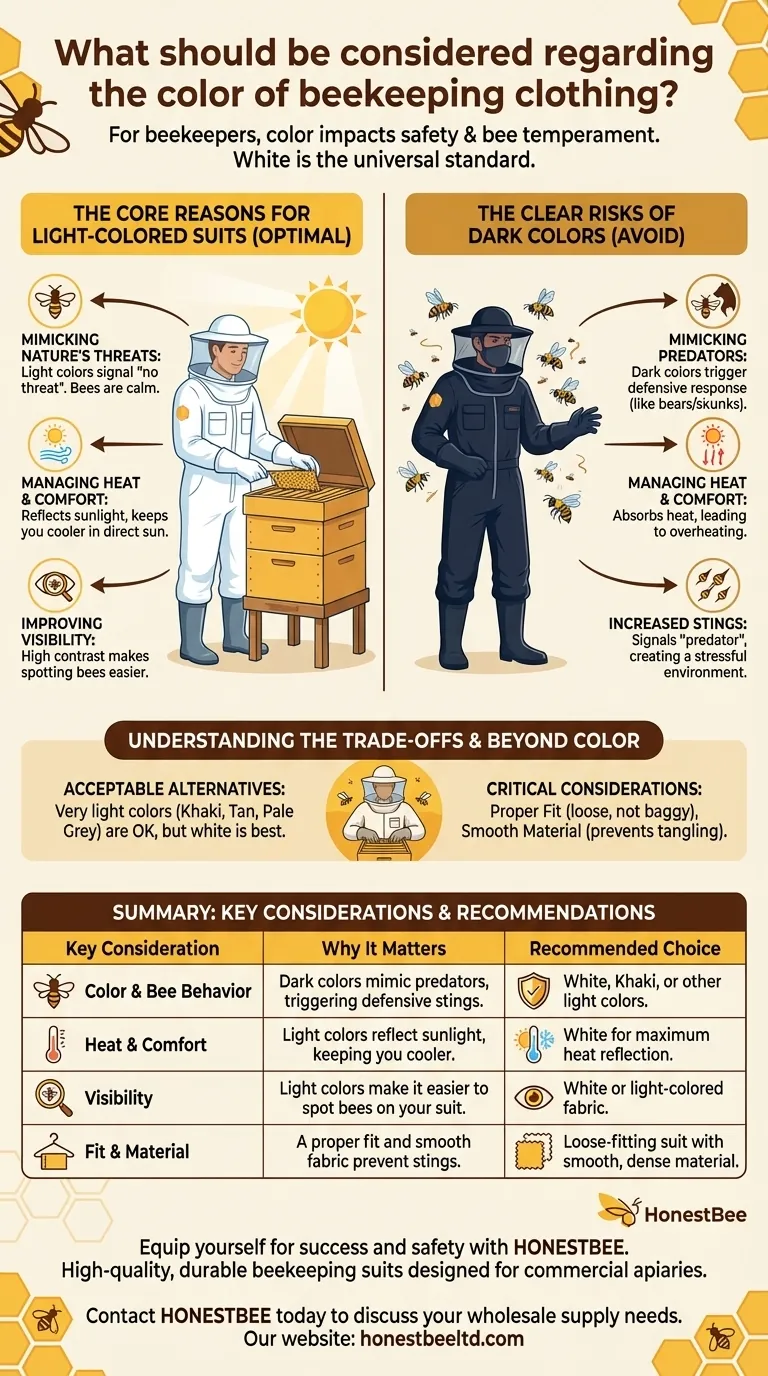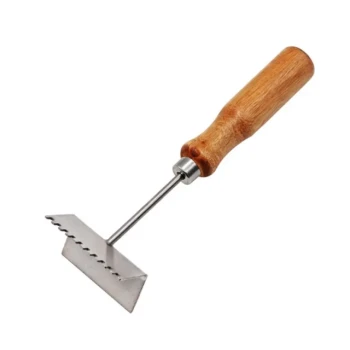For beekeepers, the color of your protective clothing is a critical decision that directly impacts both your safety and your bees' temperament. While other colors are available, white is the universal standard because it is the least provocative to bees and the most comfortable for the beekeeper in the sun.
Your choice of clothing color is not a fashion statement; it is a communication tool. Light colors signal "no threat" to your bees, while dark colors can trigger a defensive response by mimicking natural predators.
The Core Reasons for Light-Colored Suits
The recommendation for white or light-colored beekeeping suits is rooted in two distinct principles: bee biology and practical comfort. Understanding these helps you manage your hives more effectively and safely.
Mimicking Nature's Threats
Bees have evolved over millions of years to defend their colony from natural predators. These threats, such as bears, skunks, and badgers, are typically dark and furry.
When a beekeeper approaches a hive wearing dark-colored clothing, especially materials with a fuzzy or textured surface like wool or dark denim, they can inadvertently trigger this ancient defensive instinct. This results in bees that are more agitated, aggressive, and likely to sting.
Managing Heat and Comfort
Beekeeping is a hands-on activity often performed during the warmest parts of the day and year, usually in direct sunlight.
Basic physics dictates that light colors reflect sunlight and heat, while dark colors absorb it. A white suit will keep you significantly cooler than a dark one, reducing the risk of overheating and allowing you to work more comfortably for longer periods.
Improving Visibility
A light-colored suit provides a clean, high-contrast background. This makes it much easier to spot bees that may be crawling on you.
This is especially useful for finding and gently removing a bee before it has a chance to sting. It also allows you to quickly spot your queen if she happens to land on your suit during an inspection.
Understanding the Trade-offs
While white is the ideal, it's important to understand the implications of choosing other colors. The primary factor is not the specific hue, but its value—how light or dark it is.
Are Other Colors Ever Acceptable?
Yes, other very light colors like khaki, tan, or light grey are generally acceptable alternatives. The key is to remain on the pale end of the spectrum.
These colors are far less likely to provoke a defensive response than navy, brown, or black. They still present a low-threat profile to the bees.
The Clear Risks of Dark Colors
Choosing to wear dark clothing into an apiary is a significant and unnecessary risk. You are actively signaling "predator" to the guard bees.
This will almost certainly result in more stings for you and creates a stressful environment for the entire colony, whose members may remain agitated long after you have left.
Beyond Color: What Truly Matters for Protection
While color is a primary consideration, the fit and material of your suit are just as crucial for your safety and effectiveness.
The Importance of a Proper Fit
Your protective clothing should be loose enough to allow a full range of motion but not so baggy that it becomes a tripping hazard.
If the suit is too tight, a bee's stinger can penetrate the fabric and reach your skin. Conversely, if elastic cuffs at the wrists and ankles are too loose, bees can find their way inside your suit.
Material and Construction
Look for clothing made from a smooth, dense fabric. Textured or fuzzy materials can entangle a bee's legs, causing it to panic and sting. A smooth surface allows bees to land and walk without feeling trapped.
Making the Right Choice for Your Hives
Your gear selection should be a deliberate choice designed to create a calm, safe environment for you and your bees.
- If you are a new beekeeper: Stick with a white suit. It is the proven standard that removes a key variable, allowing you to focus on learning bee behavior.
- If you are an experienced beekeeper: Prioritize lightness over a specific color. Khaki or other pale colors are functional, but white remains the optimal choice for minimizing bee agitation and heat stress.
- For all beekeepers: Never sacrifice a proper fit and smooth material for color. A well-fitted suit in a light color is the ultimate combination for safety and calm inspections.
Ultimately, your protective gear should serve as a tool that fosters a peaceful partnership between you and your honeybees.

Summary Table:
| Key Consideration | Why It Matters | Recommended Choice |
|---|---|---|
| Color & Bee Behavior | Dark colors mimic predators, triggering defensive stings. | White, khaki, or other light colors. |
| Heat & Comfort | Light colors reflect sunlight, keeping you cooler. | White for maximum heat reflection. |
| Visibility | Light colors make it easier to spot bees on your suit. | White or light-colored fabric. |
| Fit & Material | A proper fit and smooth fabric prevent stings. | Loose-fitting suit with smooth, dense material. |
Equip yourself for success and safety with HONESTBEE.
Choosing the right protective gear is fundamental to a productive and safe beekeeping operation. At HONESTBEE, we supply commercial apiaries and beekeeping equipment distributors with high-quality, durable beekeeping suits and equipment designed with these critical factors in mind.
Our wholesale-focused operations ensure you get the reliable, well-fitting, and light-colored protective clothing your business depends on. Let us help you foster a calm and productive partnership with your bees.
Contact HONESTBEE today to discuss your wholesale supply needs and enhance your apiary's safety protocol.
Visual Guide

Related Products
- 3 Layer Mesh Vented Sting Proof Beekeeping Suit with Hat and Veil
- Cotton Beekeeping Suit and Round Hat with Veil Bee Keeper Protective Gear
- Vented Beekeeping Jacket with Hood and Veil for Beekeepers
- Yellow Plastic Bucket Pail Perch for Beekeeping
- Heavy-Duty Stainless Steel Clip-On Frame Perch
People Also Ask
- What are the advantages of reinforced stitching and durable zippers in beekeeping suits? Ensure Maximum Safety & Longevity
- What are the key features of the 3-layer mesh gear designed for beekeeping? Superior Protection & Ventilation
- What should be worn under beekeeping protective clothing? Maximize Your Safety with the Right Base Layer
- Why do beekeepers wear suits? Essential Protection for Hive Management
- What protective clothing do beekeepers wear? Essential Gear for Safe & Effective Beekeeping



















